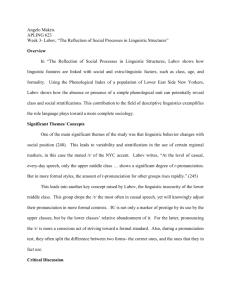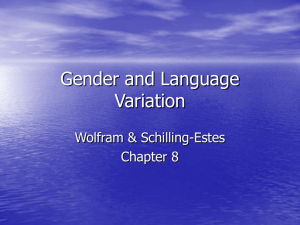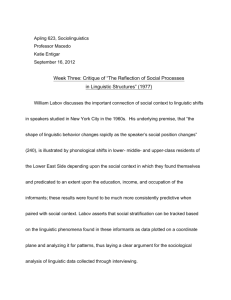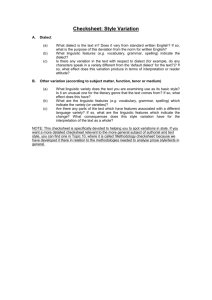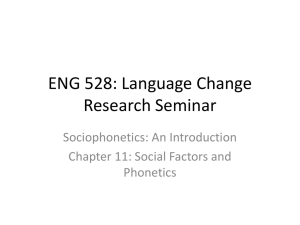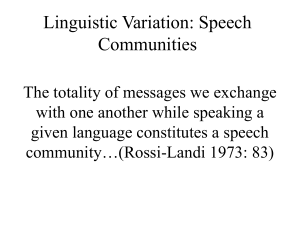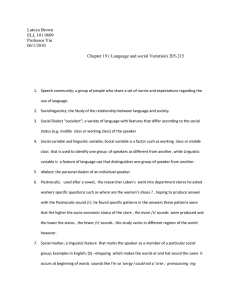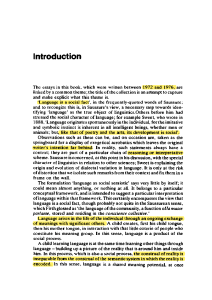Chapter 3 Social Dialectology ‘us’ vs. ‘them’
advertisement
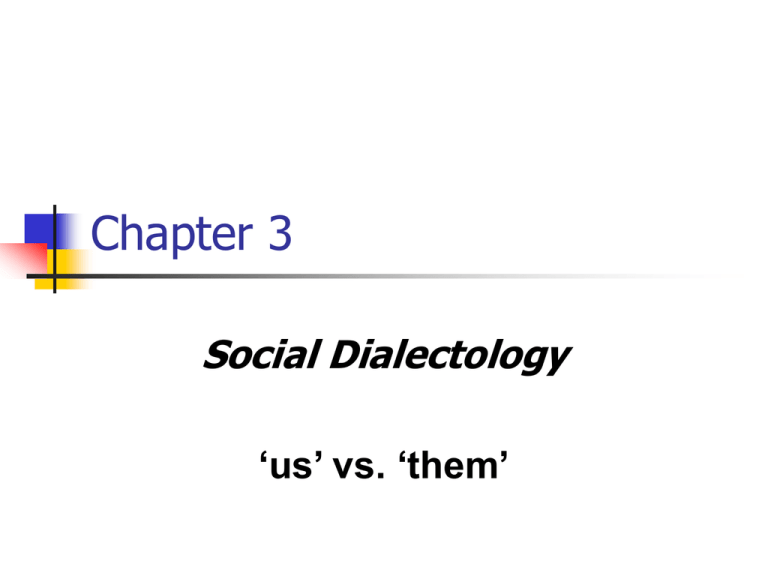
Chapter 3 Social Dialectology ‘us’ vs. ‘them’ Funny…? Speech Community: Defined Some kind of social group whose speech characteristics can be described in a coherent manner SC: Key Elements Social group “INs” & “OUTs” Shared ‘norms’ Shared language(s) Shared linguistic values Of interest to someone… (cf. “If a tree falls in the woods…”) Perceptions of Speakers Members of SC may not be aware of any linguistic ‘glue’ holding them together Solidarity factors may include: Social Cultural Political Ethnic Fischer (1958): …people adopt a variant not because it is easier to pronounce but because it expresses how they feel about their relative status versus other conversants’ Labov (1972) Language contains systematic variation which can be characterized and explained by patterns of social differentiation within speech communities Wardhaugh (2000): “The variation we see in language must partly reflect a need that people have to be seen as the same as certain other people on some occasions.” …Wardhaugh… Vocabulary I Sociolect Ideolect Informant Field method Observer’s paradox Linguistic Variable (c.f. Marker…) Social Variation Caste societies India Old Japan Old Europe Modern Western Society Similarities? Why study linguistics of social class? Attempts made to quantify class… Dave’s Soapbox Stereotypes: Useful: Tendencies of a group Dangerous: Assumptions about individuals Vocabulary II Vernacular African American Vernacular English Ebonics Prestige Hyper-correction Inherent variation Linguistic Insecurity Minimal pairs (source/sauce not minimal pair for me…) Application How would you try to place individuals according to their social position in the SC Upstate community? What factors would you consider to be relevant and how would you rate each? What class designations would seem appropriate? Consider: What did Fischer & Labov do? Optional: Where would you place yourself? Homework Identify a research project you could carry out this semester. Include: Research Question Hypothesis Implementation Strategy Review the studies in text… Simplify and extrapolate - Use the box on page 78 as a guide… Read: 92-95; 102-112; (skim 95-102) Field Methodologies Rapid Anonymous Surveys (Targeted Elicitation) Sociolinguistic Interviews Labov’s NY Department Store Labov’s Harlem Gangs Telephone Surveys Written/Electronic Surveys Not discussed in the text… Contributing Factors (partial…) Socio-economic class Style/ Register Gender/ Sexuality Race/ Ethnicity Labovs in the Making… Your research designs… Jocks, Burnouts, & Others Jocks ≈ College Prep ≈ Target ‘Prestige Dialect’ Burnouts ≈ Blue Collar Futures ≈ Target ‘Local Dialect’ Others ≠ Solidified Substratum Cf. comment on stereotypes… What’s surprising about this? Upper Class Relatively small group Hard to access Minor differences b/n U & UM classes U class characterized by Prosodic & lexical features Linguistic security (vs. insecurity) U vs. UM = status… M vs. W = class AAVE Features Omission of s in third person singular Zero possessive Zero copula Pronominal appositive Multiple negatives Cluster simplification (phonological) Language & Identity Relate Ch 3 studies to Upstate, SC In what ways does dialect reflect: upward mobility (socio-economic class) desire to move away solidarity (in Marxist terms) How does geographic location relate? Linguistics in Action Law Detecting Prosecuting Defending Business Marketing User-behavior Education 1st Language 2nd Language General Pedagogy Computers Voice recognition Usability For Tomorrow Chapter 6 184 – 196 (Sections 6.1 – 6.3)

